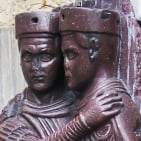A little curiosity about pnum and tnum
Options

mauro sacchetto
Posts: 353
Something escapes me on the mechanism adopted by some fonts to manage proportional and tabular numbers.
GaramondPremierePro does not seem to present proportional uppercase numbers. It contains the glyphs of the numbers (slots from 48 to 57) and those of the numbers .fitted (slots from 63033 to 63041 + 63196), but all the uppercase numbers have the same width (including the bearing, all are 486 pt), so in fact they are tabular as the .fitted ones.
However, if I compile with LaTeX I add the <lining> option, the numbers become proportional.
Did I look badly or is there some mechanism I didn't catch?
GaramondPremierePro does not seem to present proportional uppercase numbers. It contains the glyphs of the numbers (slots from 48 to 57) and those of the numbers .fitted (slots from 63033 to 63041 + 63196), but all the uppercase numbers have the same width (including the bearing, all are 486 pt), so in fact they are tabular as the .fitted ones.
However, if I compile with LaTeX I add the <lining> option, the numbers become proportional.
Did I look badly or is there some mechanism I didn't catch?
0
Comments
-
The two sets of glyphs are identical, but there are kerning pairs that affect the .fitted alternates (and none for the default figures).As a result, the .fitted figures that are substituted with {pnum} behave proportionally, even though technically they all have the same width.3
-
Ahhh ok! But what is the ratio of this choise? Other fonts have a different bearing for default (tabular) and .fitted figures. Isn't perhaps a more logical strategy?0
-
It will depend on the design of the numeral shapes and on the overall spacing. That said, since the proportional numeral 1 generally needs to be more tightly spaced to all other numerals than the tabular 1, it's more normal for the sidebearings to be adjusted than to rely on kerning.1
-
In practice, I generally duplicate my default figure glyphs for their <pnum> alternates.
Or, if the defaults are proportional, for their <tnum> alternates.
However, I often make the <tnum> glyphs for “one” wider, and the “zero” narrower, than their proportional siblings: non-identical twins.
3 -
I sometimes vary the width of a couple of other numerals, notably the 4, which can end up getting a bit pinched in tabular. Of course, the 4 is also one of the numerals that requires significant kerning in proportional, especially with 7.2
Categories
- All Categories
- 46 Introductions
- 3.8K Typeface Design
- 478 Type Design Critiques
- 556 Type Design Software
- 1.1K Type Design Technique & Theory
- 641 Type Business
- 832 Font Technology
- 29 Punchcutting
- 510 Typography
- 120 Type Education
- 315 Type History
- 75 Type Resources
- 109 Lettering and Calligraphy
- 30 Lettering Critiques
- 79 Lettering Technique & Theory
- 533 Announcements
- 86 Events
- 110 Job Postings
- 167 Type Releases
- 169 Miscellaneous News
- 274 About TypeDrawers
- 53 TypeDrawers Announcements
- 119 Suggestions and Bug Reports


